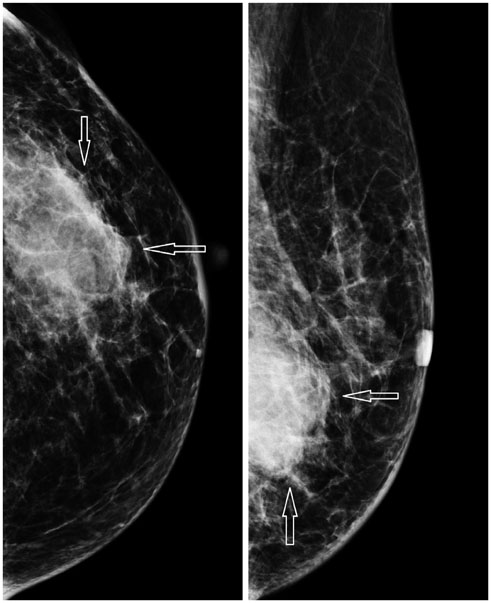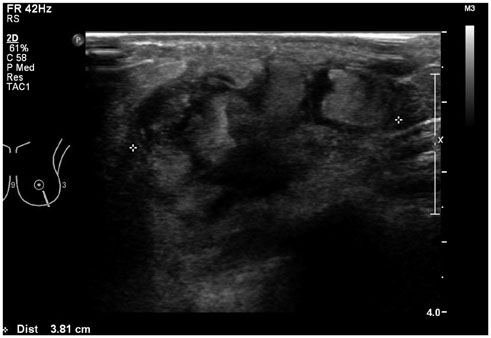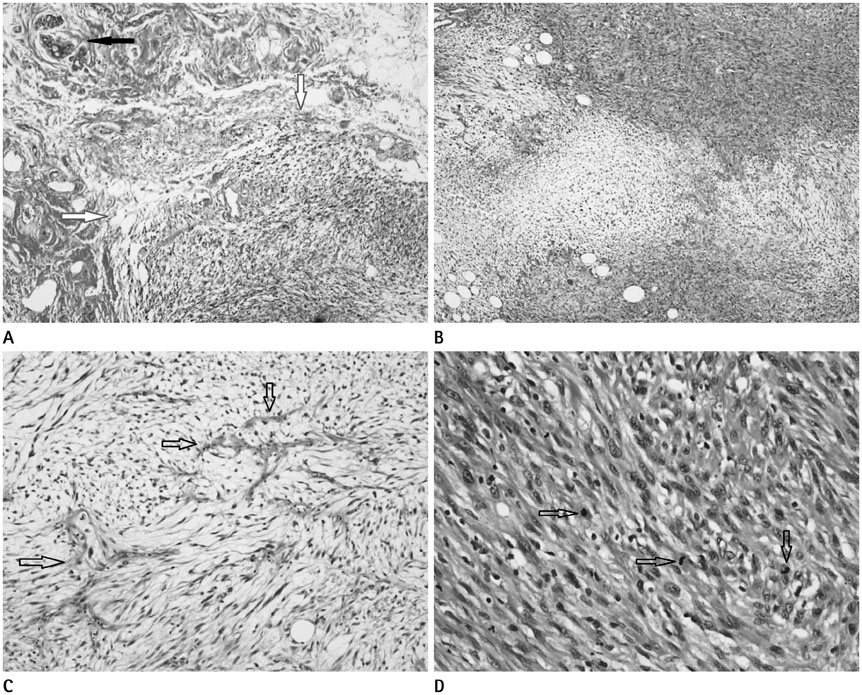J Korean Soc Radiol.
2015 Jul;73(1):53-57. 10.3348/jksr.2015.73.1.53.
Post Radiation Myxofibrosarcoma in Breast: A Case Report
- Affiliations
-
- 1Department of Radiology, College of Medicine, Yeungnam University, Daegu, Korea. raina_eleven@hanmail.net
- 2Department of Pathology, College of Medicine, Yeungnam University, Daegu, Korea.
- 3Department of General Surgery, College of Medicine, Yeungnam University, Daegu, Korea.
- KMID: 1823924
- DOI: http://doi.org/10.3348/jksr.2015.73.1.53
Abstract
- Post radiation sarcoma is a very rare and invasive malignant tumor that occurs in patients who had radiation therapy 5-10 years ago for primary cancer such as breast cancer, lung cancer or lymphoma. In recent years, the incidence of post radiation sarcoma has increased, as patients survive longer after radiation therapy. We reported a case of surgically confirmed post radiation myxofibrosarcoma from the breast of a 59-year-old woman, with a discussion on the literature.
Figure
Reference
-
1. Sheth GR, Cranmer LD, Smith BD, Grasso-Lebeau L, Lang JE. Radiation-induced sarcoma of the breast: a systematic review. Oncologist. 2012; 17:405–418.2. Labidi-Galy SI, Tassy L, Blay JY. Radiation induced soft tissue sarcoma. ESUN. 2011; 8:1–12. Available from: http://sarcomahelp.org/radiation-induced-sarcoma.html.3. Penel N, Grosjean J, Robin YM, Vanseymortier L, Clisant S, Adenis A. Frequency of certain established risk factors in soft tissue sarcomas in adults: a prospective descriptive study of 658 cases. Sarcoma. 2008; 2008:459386. [Epub]. DOI: 10.1155/2008/459386.4. Chahin F, Paramesh A, Dwivedi A, Peralta R, O'Malley B, Washington T, et al. Angiosarcoma of the breast following breast preservation therapy and local radiation therapy for breast cancer. Breast J. 2001; 7:120–123.5. Sheppard DG, Libshitz HI. Post-radiation sarcomas: a review of the clinical and imaging features in 63 cases. Clin Radiol. 2001; 56:22–29.6. Cai PQ, Wu YP, Li L, Zhang R, Xie CM, Wu PH, et al. CT and MRI of radiation-induced sarcomas of the head and neck following radiotherapy for nasopharyngeal carcinoma. Clin Radiol. 2013; 68:683–689.7. Gladdy RA, Qin LX, Moraco N, Edgar MA, Antonescu CR, Alektiar KM, et al. Do radiation-associated soft tissue sarcomas have the same prognosis as sporadic soft tissue sarcomas? J Clin Oncol. 2010; 28:2064–2069.8. Bjerkehagen B, Smeland S, Walberg L, Skjeldal S, Hall KS, Nesland JM, et al. Radiation-induced sarcoma: 25-year experience from the Norwegian Radium Hospital. Acta Oncol. 2008; 47:1475–1482.9. Neuhaus SJ, Pinnock N, Giblin V, Fisher C, Thway K, Thomas JM, et al. Treatment and outcome of radiation-induced soft-tissue sarcomas at a specialist institution. Eur J Surg Oncol. 2009; 35:654–659.10. Lagrange JL, Ramaioli A, Chateau MC, Marchal C, Resbeut M, Richaud P, et al. Sarcoma after radiation therapy: retrospective multiinstitutional study of 80 histologically confirmed cases. Radiation Therapist and Pathologist Groups of the Fédération Nationale des Centres de Lutte Contre le Cancer. Radiology. 2000; 216:197–205.





